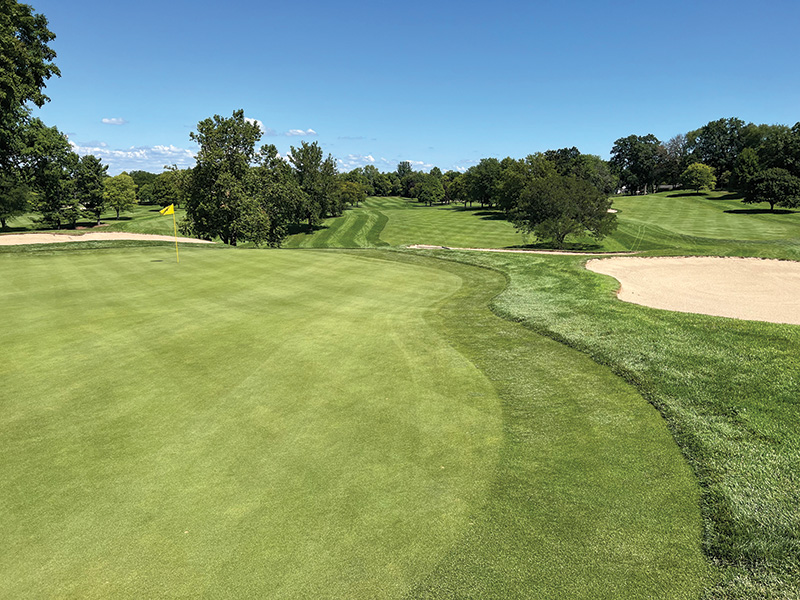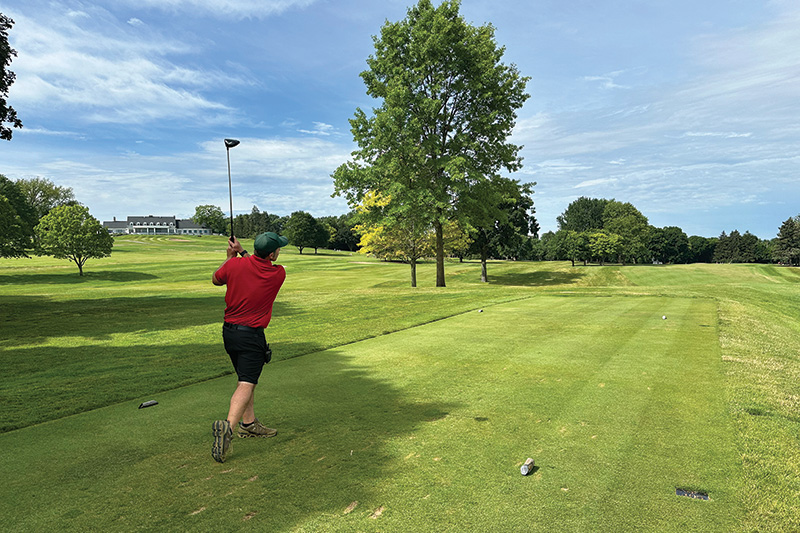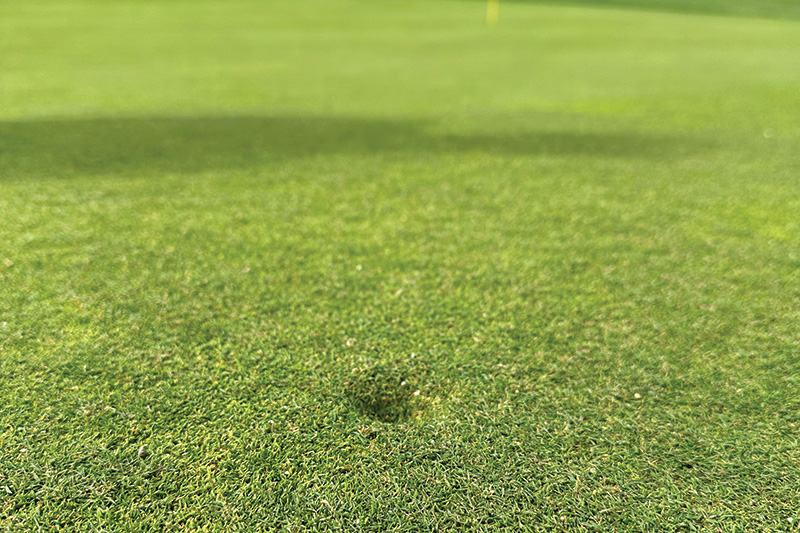
A look at Kent Country Club in Grand Rapids, Mich., where Mike Gianopoulos is the GCSAA Class A superintendent. Photo by Mike Gianopoulos
I can remember getting my first superintendent job roughly nine years ago. It was a long year, to say the least, with a lot of learning curves and trying to figure out how things worked at my course. Next thing I knew, it was time to spray for snow mold, and I had barely played any golf all season.
I have been playing golf since my dad got me started when I was 7 and have loved it ever since. That first year as a superintendent — other than my college years, when I had other priorities — made me think about why I got into this industry in the first place: because I love golf. I love the game and everything that goes into it, including my job as a superintendent. However, without the playing side of it, my job wasn’t nearly as rewarding to me on a personal level.
I got into this industry because I love golf. By not playing, how was I truly loving what I do? How do I know what my turf management decisions are doing to playability if I’m not playing on those surfaces? This realization quickly changed my perspective.
It seemed like a win-win for me to play more golf and use my round to help me manage the golf course. So, I decided that next season I was going to play at least once a week. With kids, a family and regular life, it can be hard to find the time to fit in two hours for nine holes, let alone four-plus hours for 18.
Another important factor is, after working a full day and being at your course since sunrise, a lot of times you just want to leave and go home. Why would I want to use my personal time on the range and have golfers/members coming up to me asking questions or complaining about the bunker on No. 14?
These were all thoughts I had when I considered playing at my own course more often. However, it turned out not to be like that at all. The commitment reinvigorated my passion for the game of golf, and practicing became therapeutic for me in several ways. Sure, from time to time a member would come up and want to talk about something on the course but spending five to 10 minutes with them went a long way toward making them feel heard and earning me more respect with the members.
And, honestly, every now and then you come across someone with a half decent idea.

An avid golfer, Gianopoulos says it’s important for golf course superintendents to see the course from a golfer’s perspective. Photos by Jason Brower
Know the game
Respect from your golfers and co-workers is important. You are likely to gain more respect for your job as a super if you know how to play golf. By no means do you need to be a scratch handicap, but to prove you can work your way around the golf course and have knowledge about how the game is supposed to be played goes a long way.
If you don’t know how to hit a bunker shot, how can you distinguish if the member complaining the bunker on No. 3 green is really in bad shape, or was it because they don’t know the proper technique? Being a golfer allows you to understand the challenges of hitting a ball off a fairway mowed at 0.300 inches. While that might be fun and entertaining for the low-handicap golfer, is it fun for the older and higher-handicap player? Is mowing and rolling greens daily until they’re Stimping 13-plus on the regular fun? I enjoy quicker green speeds but don’t enjoy defensive putting. It sucks the fun out quickly knowing if you miss your first putt that your comeback putt will be twice as long no matter how soft you hit it.
My goal with this article is that you pick up some tips for seeing your course from a golfer’s perspective. This isn’t meant to be a one size fits all, because course budgets and available manpower play a big role in how you’re able to maintain your course. I also hope some people will want to play more golf and in turn will have more information when it’s time to make turf management decisions on your course.
What to look for
Here are some indicators and things I have learned to look for regarding playability on greens, fairways and bunkers.
When it comes to greens, there are several things that I check and look for daily. These include firmness, smoothness, speed, texture and overall aesthetics. When you hit a shot into a green, the ball mark can tell you a lot about firmness and root density. The depth of the ball mark can be a good indicator of how firm the surface is. The deeper the mark, the softer the green. But you need to pay attention to what club you hit into the green. The higher-lofted clubs will have the ball coming in from a higher trajectory, which will naturally create a deeper ball mark. This is one of the reasons I like to keep a wedge and putter in my work cart. The other reason to use a wedge over other clubs is that the wedge is one of the most used clubs in a round of golf. Why not use the club that gets used the most when approaching greens? By hitting a wedge shot, I’m able to make notes about how deep ball marks are on a day-to-day basis and compare.
In my opinion, putting green smoothness mostly comes from a consistent topdressing program. Basic daily practices like mowing, rolling, verticutting, etc., obviously have an impact on smoothness, but topdressing sand fills in voids and imperfections while providing a true putting surface. This is where the putter in the back of the cart comes in handy. I always try to putt on several greens in the morning while analyzing how they roll, bounce and react with short and long putts.
I’m not a huge proponent of Stimping greens every day, but it’s helpful to correlate Stimping speeds with how the putts actually feel. For example, here in Michigan during the summer, our humidity increases significantly, which can lead to puffy greens. I have been able to get to a point where I can hit a putt on my first green and know roughly what the Stimpmeter reading is. I can then make a judgment call whether we need more inputs that day to get the speed where we want it to be. If it’s an 11 and the putt you usually hit ends up short, maybe the Stimp reading was done incorrectly. Maybe it’s worth calling for the extra roll that day. I have made several course adjustments on the fly based on how the greens were rolling that morning. I have noticed on my greens that when things are good and moving at a nice pace (11 plus), the ball seems to have an extra couple of rolls at the end. Just when it looks like it’s about to stop, it goes another one or two revolutions. There are subtle clues and benchmarks at every course that you can use. You just have to find them.
Another important playability factor is how your tee shot reacts in the fairway. Clues such as mud on the ball or just a visual inspection of how much of a bounce you get when it hits the fairway can tell a lot. There’s a delicate balance between keeping the grass alive and healthy versus keeping it in the best playable condition possible. Everyone wants firm fairways because you get extra roll and yardage out of them versus soft fairways, where balls can plug and get minimal to no roll. I try to water just enough to keep things green but right on the edge of turning off-color because of dryness. There’s a slight mottled look to them, and I think that is when they are dialed in the best. Things are on the dry side but not quite on the brink of death. However, these conditions are not always attainable day in and day out because Mother Nature always wins. You might get into a hot/humid stretch in which keeping the fairways that close to death for playability isn’t worth it.

Ball marks can tell superintendents a lot about their playing surfaces, but the author says it’s important to consider the club that hit the shot that created the mark.
About those bunkers …
Bunker playability is always a big topic for golfers and a huge labor cost every season. In the end, they are hazards, but it’s safe to say we have all had the classic fried egg lie or plugged ball in the face. I’ve yet to see anyone walk up to their ball in those situations and be happy about it.
There are a few ways to mitigate that to keep things in check.
One thing I will do about weekly is to hit shots intentionally into greenside bunkers. I really think that’s the best way to get an authentic ball reaction in the sand. I’ve seen plenty of people, me included, throw a ball as hard as they can straight into the face to see if it plugs. I think that can be a useful technique, but when someone hits their ball into a bunker, that’s not typically the trajectory of a golf shot. Shot trajectories can vary a lot depending on the club used, distance, wind, etc.
I like to hit wedges into them for two reasons: The wedge shot is typically going to come in at a steeper angle from the higher trajectory (has an increased chance to plug compared to other clubs), and the shot you hit is going to be closer (it’s easier to hit into the bunker from 80 yards versus 150 yards). We are essentially trying our hardest to get the ball to plug by hitting a wedge, so if it doesn’t, chances are good that other clubs coming in at a shallower angle will be less likely to plug in the first place. Not everyone might be able to hit it in a bunker from 80 yards easily, so even pitching balls into the bunker faces from closer distances can give you an idea of how it will react.
At the start of every season, we make it a point to go through every bunker and check sand depths throughout. Sand depth plays a large part in how moisture drains through the bunker and can have a significant impact on playability.
Over the course of a season, sand can and will move throughout the bunker — largely the result of mechanical machines that rake the bunkers. This is due to the machine exiting the bunker and always dragging a little bit of sand with it until the rakes are picked up. Using the same entrances and exits of a bunker leads to sand piling up in the same spot every time it is raked. This in turn leads to a lack of consistency in the bunker. Some areas will have extra sand and be fluffier/softer, while others will have too little sand and play more firmly while risking the golfer bottoming out their club or hitting gravel.
A new perspective
When it comes to playing golf on your course, I recommend riding and walking when you play. The biggest advantage of playing your course is seeing the golf course from the golfer’s or member’s perspective. So often we get into routines of driving around the course and looking at the same areas and only seeing it from the superintendent’s perspective.
When you play golf, you’re going to be driving/walking from No. 1 green to No. 2 tee, or you might hit your drive into the right rough on No. 4. Odds are good that just by playing golf, you will see other areas of the course that you as the superintendent might not see that frequently.
Another tip for getting into the golfer’s perspective is to pretend you are a guest coming to your club for the first time. Leave your shop and drive in the club entrance. Park where members/golfers park. Walk to the pro shop/locker room door and make the walk from the pro shop to the putting green. Make the drive/walk from the pro shop to the range, etc. This is all in an effort to see what the golfer/guest sees when they arrive.
How does the landscaping around the clubhouse look? How do the trees, shrubs, flowers, and landscaping look when you’re driving into the parking lot? What kind of things do you see on the walk from your car to the pro shop?
Our job, just like life, is about perspective. Sometimes we get so ingrained with how we do things that we forget to step back and look at it from a different angle. There is so much we can learn and improve on from seeing our club from a golfer’s perspective.
Mike Gianopoulos, GCSAA Class A superintendent at Kent Country Club in Grand Rapids, Mich., is a 16-year member of the association.